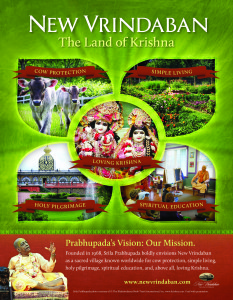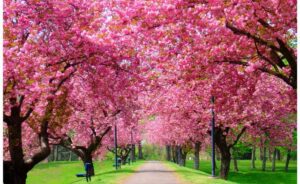By Madhava Smullen
ISKCON New Vrindaban and Eco-Vrindaban’s latest Department Head reports, on March 14th, showed that devotees were continuing to cooperate together with encouraging progress towards crystallizing Srila Prabhupada’s vision.
Co-GBC and MC for the day Anuttama Das introduced the event, explaining that since 2011, INV and ECO-V’s Boards of Directors and their managers and staff have gathered to communicate accomplishments of the past year and plans for the upcoming one.
But two years ago, they decided to make the gatherings open for all New Vrindaban residents and well-wishers to participate in. Sure enough, a sizeable group of residents were present, including longtime resident Varshana Swami, who offered a beautiful invocation that set the mood and intent for the weekend.
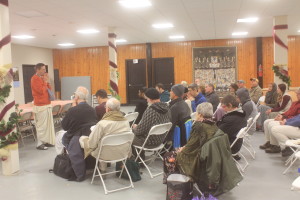
Jaya Krsna Prabhu leads prayer at beginning of presentation.
New ECO-V chairman Bhima Walker then introduced ECO-V’s department heads, beginning with interim Flower Garden manager Vidya Dasi. Vidya’s plans for the year included maintaining all the flower gardens; giving guests the experience of picking flowers and making garlands for Krishna; and creating an inviting atmosphere by adding benches, garden art and well-designed flower beds to the front of the temple.
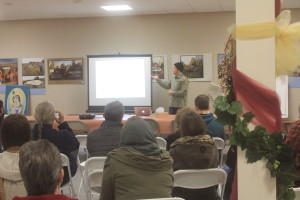
Bhima presents ECO-V
Next, Ananda Vidya Das and his wife Lalita Gopi Dasi from Cow Care and Milking described how they get 30 gallons a day from their seven milking cows – enough for all the temple’s needs — and supply the Deity kitchen with butter, ghee, yoghurt and curd. They reported high standards of cow care, announced that two new calves were expected soon, and were glad that the milking barn’s ceiling had been insulated to make winters serving there easier.
Brand new ECO-V Project Manager Mukunda Das, who will be moving to New Vrindaban in May, said that initial teams had already been but together to discuss plans for an eco-village and food processing facility; and that he would be working on eco-friendly housing beginning with one demonstration home.
Bhakta Richard of the Ox Program reported that the three young teams of Isan and Balarama, Hari and Priya, and Manu and Nandi are all making great progress in training with the yoke and learning commands. In addition, oxen moved into the rebuilt Bahulaban ox barn at the end of last year; ox cart designs have been presented by carpenter Vyasasana Das; and a turnstyle that can run a saw or mill with ox power has been acquired.
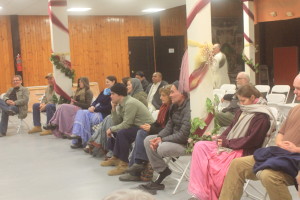
Crowd listens attentively at presentations.
Gopal’s Garden, the homeschool co-op run by Ruci Dasi, reported a new preschool for two to four-year-olds, a fundraising drive for improving its playground, and input from many members of the community. Proving that it does indeed take a village to raise a child, they teach such subjects as dramatic reading, literature, poetry, Deity worship, kirtan, art, and music. The school also has a charming new logo featuring youthful Krishna playing His flute.

Gopals Garden Logo final
ISKCON New Vrindaban community president Jaya Krishna Das then introduced INV by sharing its new mission statement: “To please Srila Prabhupada by promoting his vision for New Vrindaban through steady development of Simple Living, Holy Pilgrimage, Community Outreach, Spiritual Education, and, above all, Loving Krishna.”
Local brahmachari Bhakta Trevor with Community Outreach was first up for INV. He reported that he maintains regular Harinam Sankirtan and book distribution in Wheeling and Pittsburgh; is starting home programs in Morgantown; and plans to start a Krishna Club at West Virginia University, where students are already chanting. He also holds a weekly kirtan at Wheeling’s new age store The Noble Source, where the owner chants and keeps Prabhupada’s books. He has done all this, he said, through making friends and building loving relationships.
The super-busy Vrindavan Das reported on the three departments he oversees, beginning with Communications, in which he talked about making friendships with locals and students; inviting the Mayor of Wheeling and Moundsville City manager to Festival of Colors and Rathayatra; developing an attractive monthly newsletter; and having regular articles published on ISKCON News, Dandavats, Brijabasi Spirit, and also in the secular media.
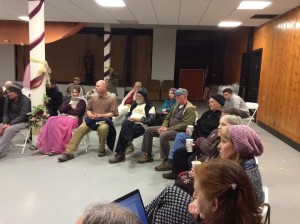
In Marketing, Vrindavan outlined plans to launch New Vrindaban’s new website this year, and create an attention-grabbing brochure for the Palace of Gold and New Vrindaban which will be placed in visitors bureaus, local tourist attractions, and hotels. He also plans to place permanent billboards on two major highways to promote the Palace of Gold by mid May this year.
In Festivals, he said he planned to make national events of Nrsimha Chaturdasi and of Srila Prabhupada’s Appearance and Disappearance Days at his Palace. He also talked about plans to hold an early July retreat this year with Bhakti Charu Swami; open Rathayatra at New Vrindaban to the Ohio Valley public; and replicate Prabhupada’s Bhagavat Dharma Discourses. He also hoped to enhance national participation in Kartik, the 24 Hour Kirtans, Festival of Colors, and Festival of Inspiration, which expects a bigger crowd this year with Jayapataka Swami attending.
In an encouraging step towards succession, a father and son team presented next. Guest Lodge manager Gaura Bhakta reduced prices for rooms and cabins, and plans to install lights to guide guests to the Welcome Center at night. He also hopes to increase guest visits during weekdays; and to have four new rooms with attached bathrooms on the ground floor by this year’s Festival of Inspiration.
His father Vasudeva Das plans to keep Govinda’s Restaurant open longer each year, from March 28th to January 2nd, to launch a new webpage for it, and to add new uniforms and name tags for staff. He reported that Govinda’s used only in-house dairy for the past six months, and announced the arrival of new cook Sri Rupa Das from Mumbai; and new menu items such as Indian sweets, Italian lasagna and canelonis, and Mexican items like burritos.
Vasudeva also reported on the Devotee Kitchen, which is working on creating a balanced diet for devotees so that they get proper nutrition. The kitchen will be getting a new altar and a new oven this year. It is also mainly using New Vrindaban protected dairy and has dramatically increased use of locally grown produce.
In Palace Restoration, Gopisa Das has a plan to expand the parking lot of Srila Prabhupada’s Palace from 18 parking spaces to 80, with a bus turnaround. He also plans to complete the outer wall and upper steps this year, with the lower steps and entry railing to follow.
In Facilities, also overseen by Gopisa, the library, third floor residential rooms and hallway from the kitchen to the temple room were renovated, and frozen pipes and radiators fixed. This year, Gopisa plans to upgrade the temple and lodge’s electrical systems, and renovate the lodge bathrooms, restaurant kitchen, temple siding and entry doors, cabin roofs, and swan boat house.
In the Palace Rose Garden, Gopalasyapriya Dasi spoke about her plan to stop using chemical fertilizers and start using more natural methods with the help of Paul Zimmerman of the American Rose Society, who recently did the same for the famous Biltmore Gardens in North Carolina. This, she felt, would attract a lot of people.
Speaking for Varshana Swami, Jaya Krishna reported that the Land Management department is working on the Palace parking lot and improving roads, drainage, and the Govardhana Parikrama path; but that it needs qualified young personnel to replace Maharaja, who is suffering from health problems.
In 2015, Treasurer Laxmi Honest aims to make sure funds for helping devotees through capital improvements and housing are used for those purposes only. She will also provide all department heads with “monthly budget vs actual” reports so that they can understand where they can spend less and more.
A new addition to Congregational Development, Daya Gauranga Das, reported a team of five preachers and a plan to increase fundraising 14% this year. However, he also emphasized that the the focus of congregational development was not taking but giving, by sharing with people a spiritual solution to their problems. He announced that five “Lila Sthalis,” or places of the Lord’s pastimes, would be marked on the community’s Govardhana Parikrama path with dioramas and art, and that Dina Bandhu Das will launch an annual Braj Mandala Parikrama at New Vrindaban this May.
Last but certainly not least came the Deity Department, headed up by Abhinandana Das. This year it created a sustainable and reliable team of pujaris with a family mood of cooperation; maintained punctuality and high cooking standards; and renovated the Deity kitchen and pujari room. In 2015, the pujaris plan to re-launch the Deity sewing room to fix old and torn outfits; extend the dressing room to create more space for the Lord’s outfits; build a new house for Tulasi Devi; and facilitate a second ISKCON Deity Worship Ministry training course.
As the presentations ended, Jaya Krishna, in a generous guesture, offered everyone a bag of Govardhana dust and CDs from his recent Braj Mandala Parikrama in Vrindavana, India.
He also invited all to take a copy of the beautifully designed “Prabhupada’s Vision: Our Mission” poster, saying, “Please take one and put it up on your refrigerator or next to your altar so that we are reminded daily of what Srila Prabhupada wants from us.”
His request reflected how many board members, managers, and New Vrindaban residents left the presentations – newly energized and refocused on Srila Prabhupada’s vision for his first rural community.
